

In February 2011 MINI released a new option Sport Pack, based on the John Cooper Works conversion, which was available on the Hatch and Convertible models. The pack featured an aerodynamic package, which included unique front and rear aprons and a honeycomb mesh over the main air intake. Inside, Sport Pack cars received the same black leather sports steering wheel as the JCW, cloth/leather sports seats and Piano Black trim, as well as lightweight 17in JCW cross-spoke alloy wheels. The Sport Pack was also fitted with dynamic traction control and electronic differential lock control, further improving the car’s handling and enhancing driver engagement. The Sport Pack wasn’t exactly a quick bolt-on, however, and it came at a price, starting from £2,150 for the MINI One and rising to £2,995 for the Mini Cooper and Cooper D Convertible. In the UK, MINI also announced two special edition cars: the MINI Clubman Hampton and the MINI Pimlico.
These two cars were to promote a new customization programme called MINI Yours, which further enhanced the MINI’s ever-growing range of customization options; it would be on sale for just twelve months. The Clubman Hampton was finished in bespoke Reef Blue metallic paint with a Silver roof, rear door surrounds and Damson Red detailing. All Clubman Hamptons were fitted with MINI’s Chilli Pack, and 17in, twin-spoke alloy wheels. For the entry-level Cooper version of the Clubman Hampton you’d be looking at a £20,360 price tag, while the Cooper SD jumped to £23,185. The hatch-only MINI Pimlico came in a much more vibrant Laser Blue metallic paint finish, which was originally only available on the Cooper S and JCW cars. It was also fitted with 16in JCW, twin-spoke alloy wheels, and featured a Piano Black interior. The MINI Pimlicos were priced a little cheaper, starting at £ 14,465 for the MINI One.
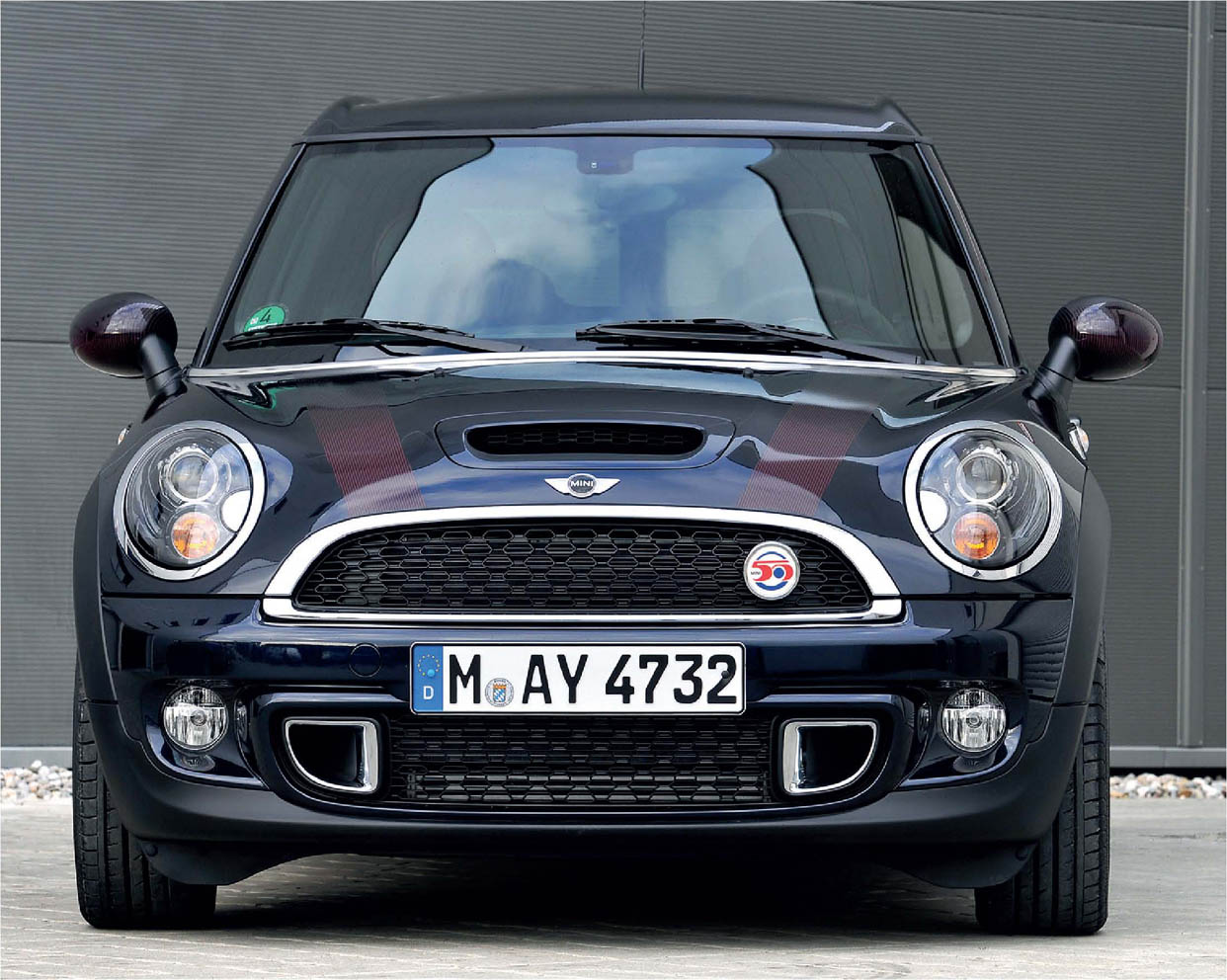
In 2011, BMW announced two special MINI editions: the Clubman Hampton and the Pimlico. NEWSPRESS
‘MINI INSPIRED BY GOODWOOD’
Continuing to add to its string of limited and special edition models, in April 2011 the most luxurious MINI ever to be produced was unveiled: ‘MINI Inspired by Goodwood’ was limited to a production run of 1,000 cars, which were built under the watchful eye of BMW Group’s partner company and British premium car maker, Rolls-Royce. Powered by the same 1.6-litre, 184bhp turbocharged engine that powers the Cooper S, the premium-packaged MINI was a mini Rolls-Royce. The Goodwood edition was rather modest in its appearance, so unless you are a red hot MINI fanatic, you would have to look twice. The trim colours, equipment and detailing were all decided by Alan Sheppard of Rolls-Royce design. Unlike the other MINI models, the Goodwood edition received a specifically selected central console, air vents, carpets, lounge leather seats, roof lining, door and interior cladding materials, all of which were finished in the carmaker’s Cornsilk colouring. In addition, the dashboard and door-handle surfaces – manufactured at Goodwood – are finished in the typical and traditional premium wood trim, Walnut Burr, exclusive to Rolls-Royce.
The ‘MINI Inspired by Goodwood’ was also crammed with a range of technical gadgets, including Xenon adaptive headlights, park distance control, automatic air conditioning, and the MINI’s audio system, radio MINI visual boost, which features the Harman Kardon hi-fi speaker kit. To achieve a striking yet tasteful appearance, the ‘MINI Inspired by Goodwood’ was finished in metallic Diamond Black, exclusive to Rolls-Royce, which is highlighted by 17in lightweight, multi-spoke alloy wheels. Following BMW’s announcement that the Goodwood MINI was on its way, the car made its debut at the Shanghai Motor Show, which is also when the brand dropped the price-related bomb: this little car was destined to receive a £40,000 price tag.
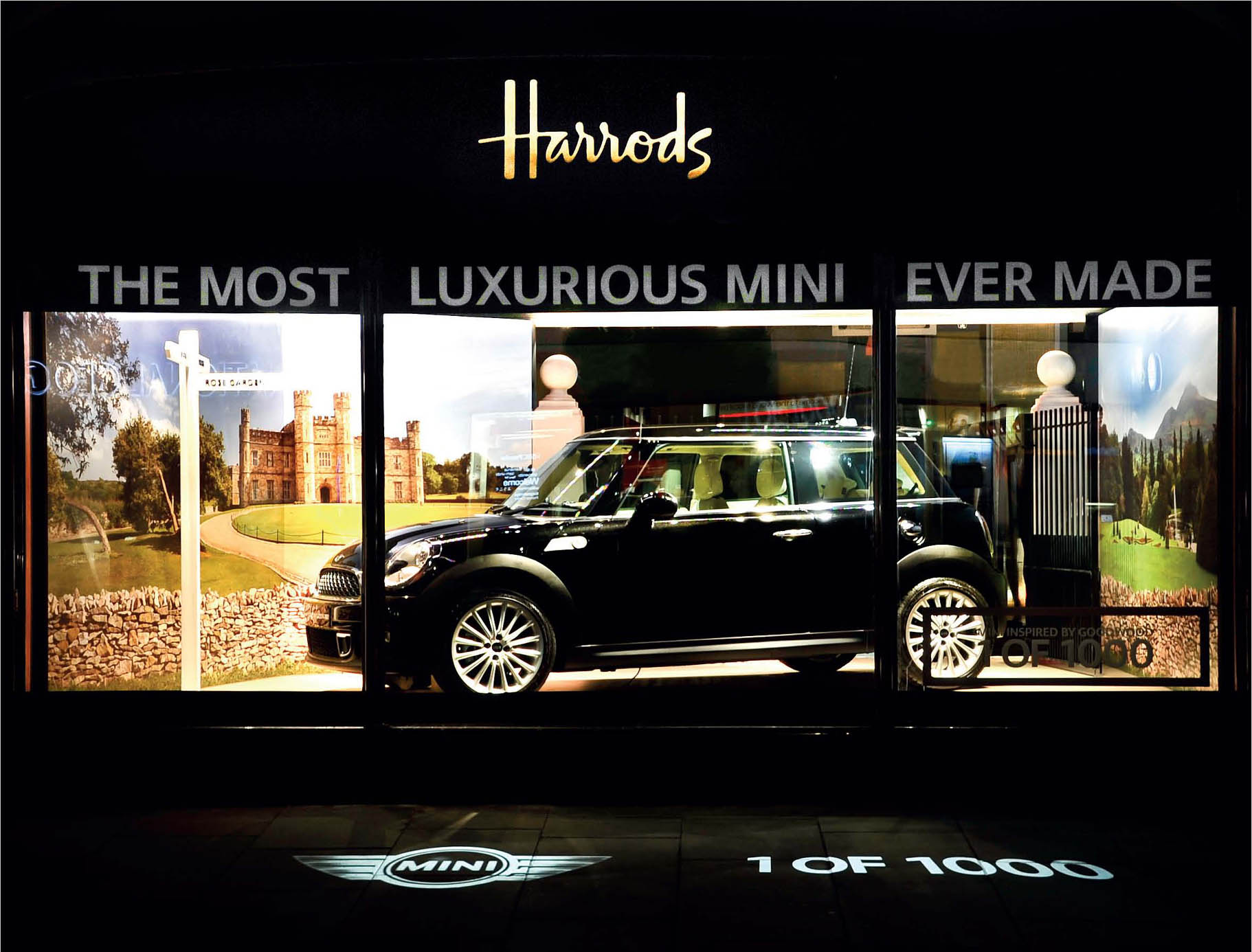
‘MINI Inspired by Goodwood’ was the most luxurious MINI ever made. NEWSPRESS
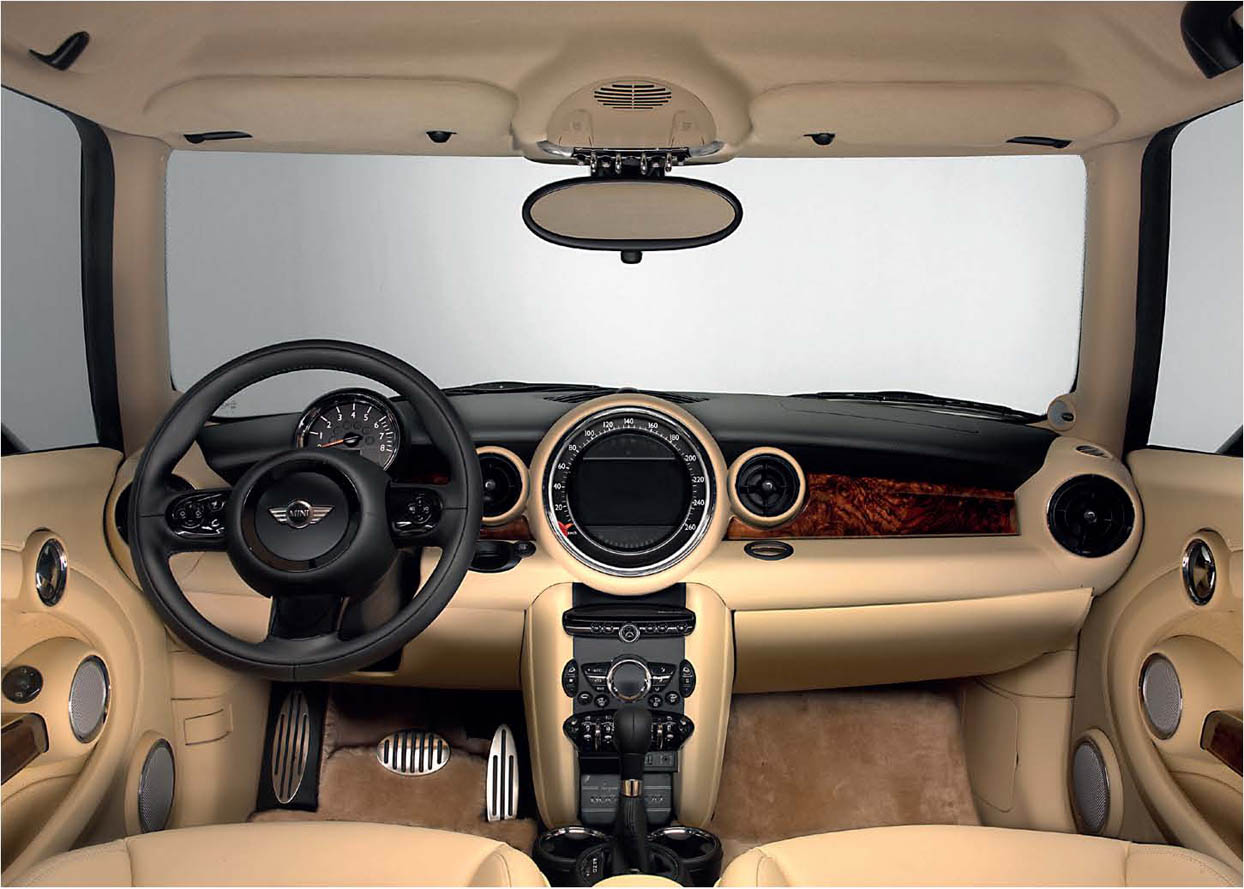
The Goodwood MINI was built under the watchful eye of British premium carmaker, Rolls-Royce. NEWSPRESS
THE MINI COUNTRYMAN, R60
The MINI Countryman R60 was announced in January 2010. As MINI’s first Crossover SUV (Sports Utility Vehicle) – not to mention the first five-door MINI model to be launched in BMW’s era – it caused quite a stir; however, although it bears the historical ‘Countryman’ name, the new, five-door variation is a completely different car to that of the woodtrimmed estate car of the 1960s. Built at BMW’s plant at Magna Steyr in Austria, the SUV is offered in a choice of two- or four-wheel-drive (known as ALL4), and is powered by the same 1.6-litre 4-cylinder petrol or 2.0-litre 4-cylinder diesel engines in the hatchback or Clubman, which can be paired to a sixspeed manual or a six-speed automatic gearbox (the automatic is not available on the entry-level One). Being an SUV, the Countryman aims to provide small families with a multi-functional vehicle that boasts plenty of space as well as fun driving characteristics; it therefore has a longer wheelbase, a much roomier cabin space and higher ground clearance in comparison to the Clubman estate. However, it is important to understand that MINI’s ALL4 doesn’t make the Countryman an off-road warrior that could live up to the expectations of a Land Rover.
As an option, the Cooper S and Cooper D variants are available with permanent ALL4 all-wheel-drive, an electrohydraulic differential positioned directly on the final drive, varying the distribution from front to rear in an infinite process. ALL4 allows the Countryman to cope better in a range of conditions and when driving on rugged surfaces. In normal driving conditions, up to 50 per cent of the power generated is used to drive the rear wheels, but in extreme conditions this increases to 100 per cent. This drivetrain technology is based on the high-end MINI suspension, including the front axle with MacPherson spring struts and forged track-rod arms, the multi-arm rear axle, and electric power steering with Servotronic.
The Countryman also received dynamic stability control (DSC) as standard, dynamic traction control (DTC) as standard on either the Cooper S or Cooper D ALL4 models, and an electronic limited-slip differential for the front axle. As far as MINIs go, this was the largest and most unfamiliar variant to leave the production line. Most people would refer to this particular car as a ‘biggie’, because it is significantly larger than the R56 family and sits higher off the ground. It comes with the standard four-seat arrangement, but is even offered with a three-seat bench at no extra cost, helping to provide more room for larger families.
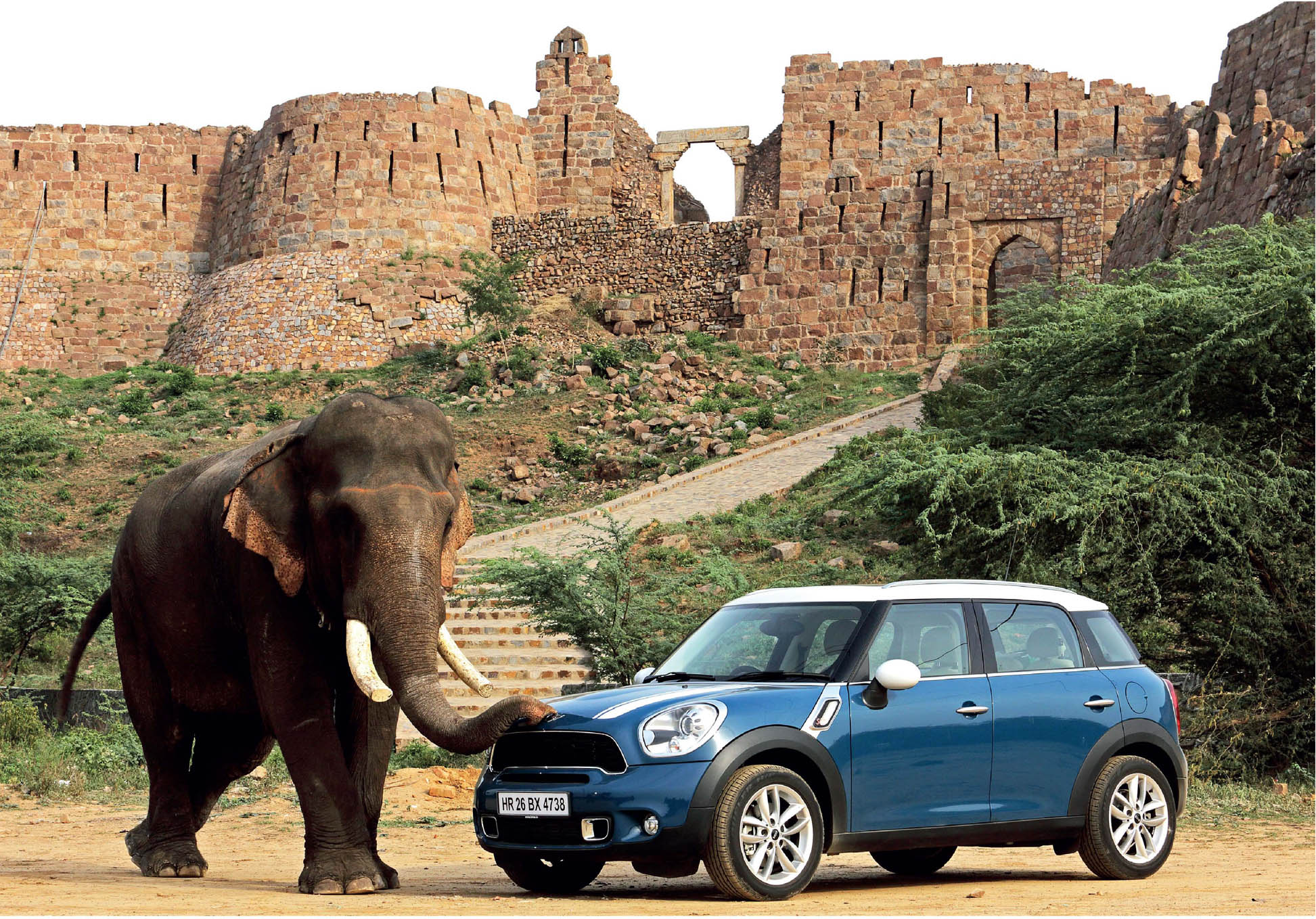
The Countryman was announced in January 2010 as MINI’s first Crossover SUV. NEWSPRESS
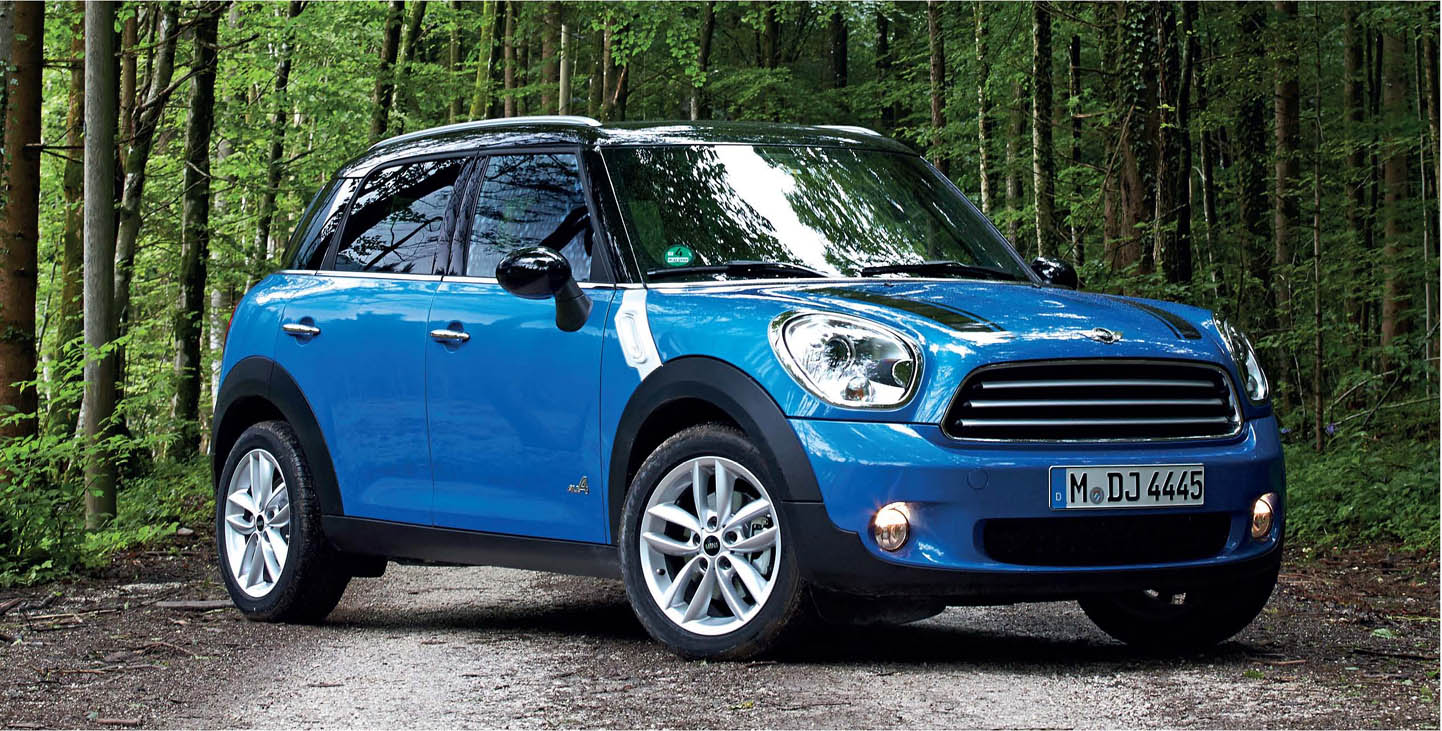
The Countryman is offered in a choice of two-or four-wheel-drive (known as ALL4). NEWSPRESS
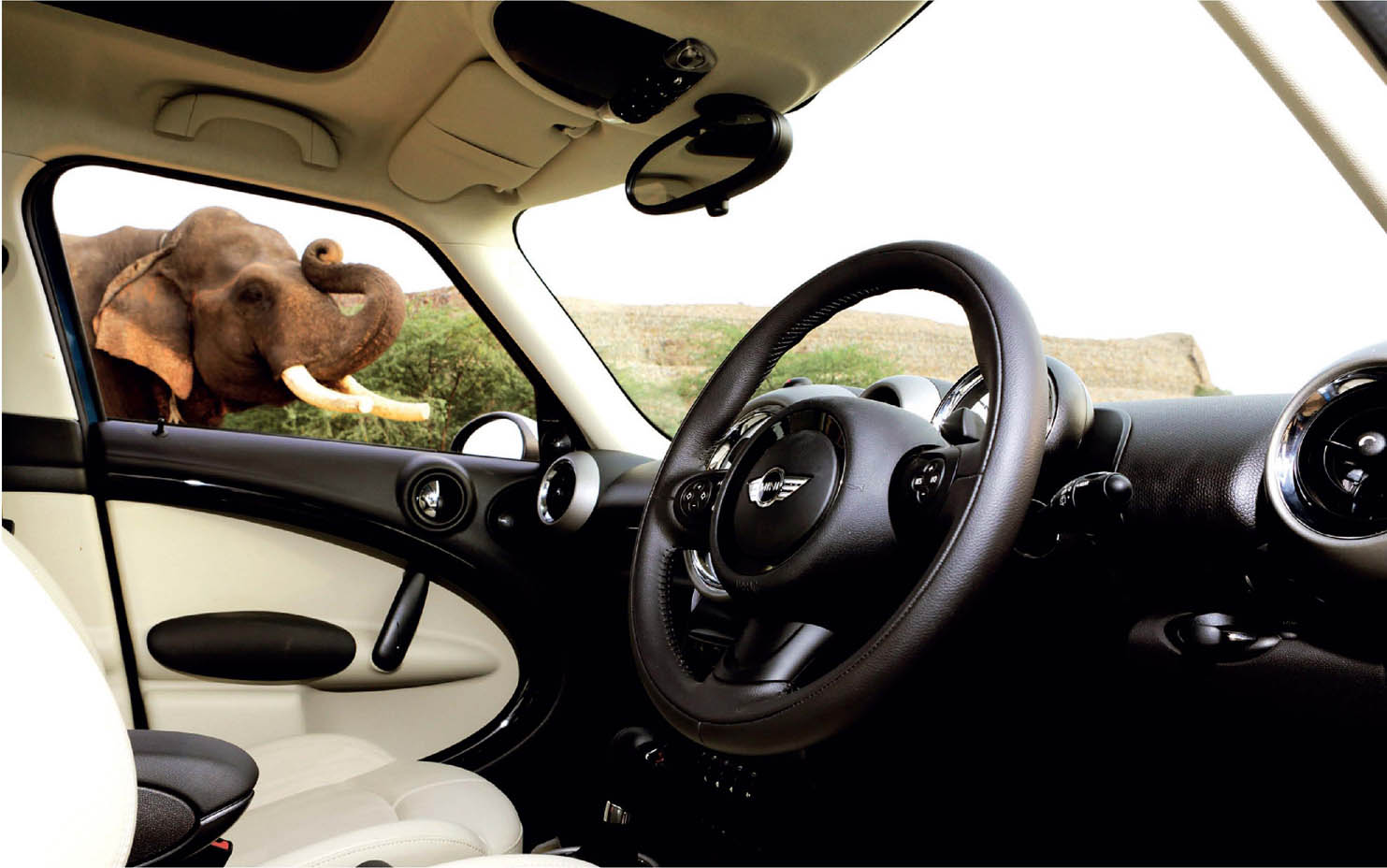
The Countryman was designed to provide more room for larger families. NEWSPRESS
THE COUPÉ
MINI first revealed the Coupé in June 2011: it was the first two-seater MINI, and the first to feature a three-box design, where the engine compartment, passenger compartment and luggage compartments are all separated. In John Cooper Works specification, the Coupé also became the fastest production MINI to hit the road, with a 0–100km/h sprint time of 6.4sec and a top speed of 149mph (240km/h). The Coupé could also be ordered with the most powerful petrol and diesel engines in the brand’s line-up, leaving buyers with a choice of the 122bhp Cooper Coupé, the 143bhp Cooper SD Coupé, the 184bhp Cooper S Coupé and the range-topping 208bhp JCW Coupé, all of which are mated to a six-speed manual gearbox.
Built at MINI Plant Oxford, the Coupé shares the same floorpan as the MINI Convertible, ensuring that it has the strongest body of all models. The Coupé’s ‘helmet roof’ was the key talking point for the model variant, which featured a fixed spoiler at the rear of the roof, and an active spoiler that rises from the lower section of the hatch at 50mph (80km/h) and drops down again at 37mph (60km/h), to help improve aerodynamic balance and road grip at high speeds by reducing lift at the rear axle. Since the Coupé doesn’t have rear seats, it does boast a healthy-sized boot space at 280ltr (9.9cu ft), making it an ideal and practical vehicle choice for two people. Also adding to its appeal, prices for the MINI Coupé remained similar to the Hatch and Convertible, with prices starting from £ 16,640 for the Cooper and rising to £23,795 for the JCW.
Following the announcement that the new Coupé would go on sale in October 2011, MINI also revealed details of a racing Coupé – the John Cooper Works Coupé Endurance – specifically developed to compete in the forthcoming twenty-four-hour race at the Nürburgring in June; however, this never reached production. The tweaked 1.6-litre JCW unit could churn out an astonishing 247bhp and up to 239Nm of torque on over-boost. The JCW Coupé is cramped, completely impractical and ludicrously loud, but more importantly, it is a hell of a lot of fun, true MINI style.
THE TWO-MILLIONTH MINI
A decade after the very first R50 MINI rolled off the production line at MINI Plant Oxford, the 2 millionth example was driven off the line by Prime Minister David Cameron in September 2011. Frank-Peter Arndt, responsible for MINI production, was in attendance to celebrate the latest milestone for both MINI and Plant Oxford, which had already seen its fair share of automotive icons fire up into life. Of the 2 million MINIs produced since 2001, more than 1.5 million had been exported from the UK, much like its predecessor, which left BMC and BL struggling to meet home-market demand towards its final days.
The 2-millionth MINI to be built was a Convertible, specially painted in White Silver metallic with a Blue Denim roof. Since this was a very special MINI, it received a range of bespoke interior and exterior qualities, including a distinctive leather steering wheel and lounge leather upholstery. This historic car was also given away as a prize in the global Facebook campaign Two Million MINIs – Two Million Faces’. The competition was pretty much what it said on the tin: 2 million photographs of 2 million MINI fan faces collected to create a dedicated Facebook ‘wall’. Of the 2 million participants, one lucky winner was awarded the official 2-millionth MINI. It was during this event that Frank-Peter Arndt briefed David Cameron on BMW Group’s preparations to produce the third generation MINI, as well as new production facilities, helping to ensure a bright future for MINI Plant Oxford and thousands of jobs at the pressing plant in Swindon and the engine plant at Hams Hall near Birmingham.
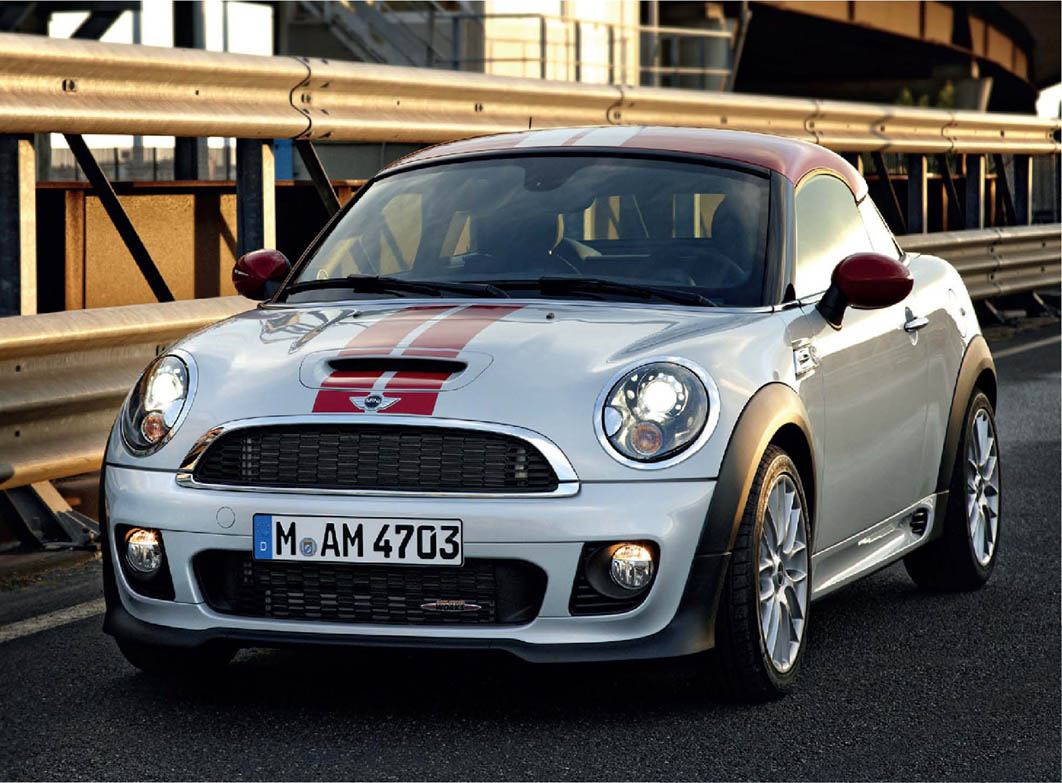
The Coupé was revealed in June 2011, and would become the first two-seater MINI. NEWSPRESS
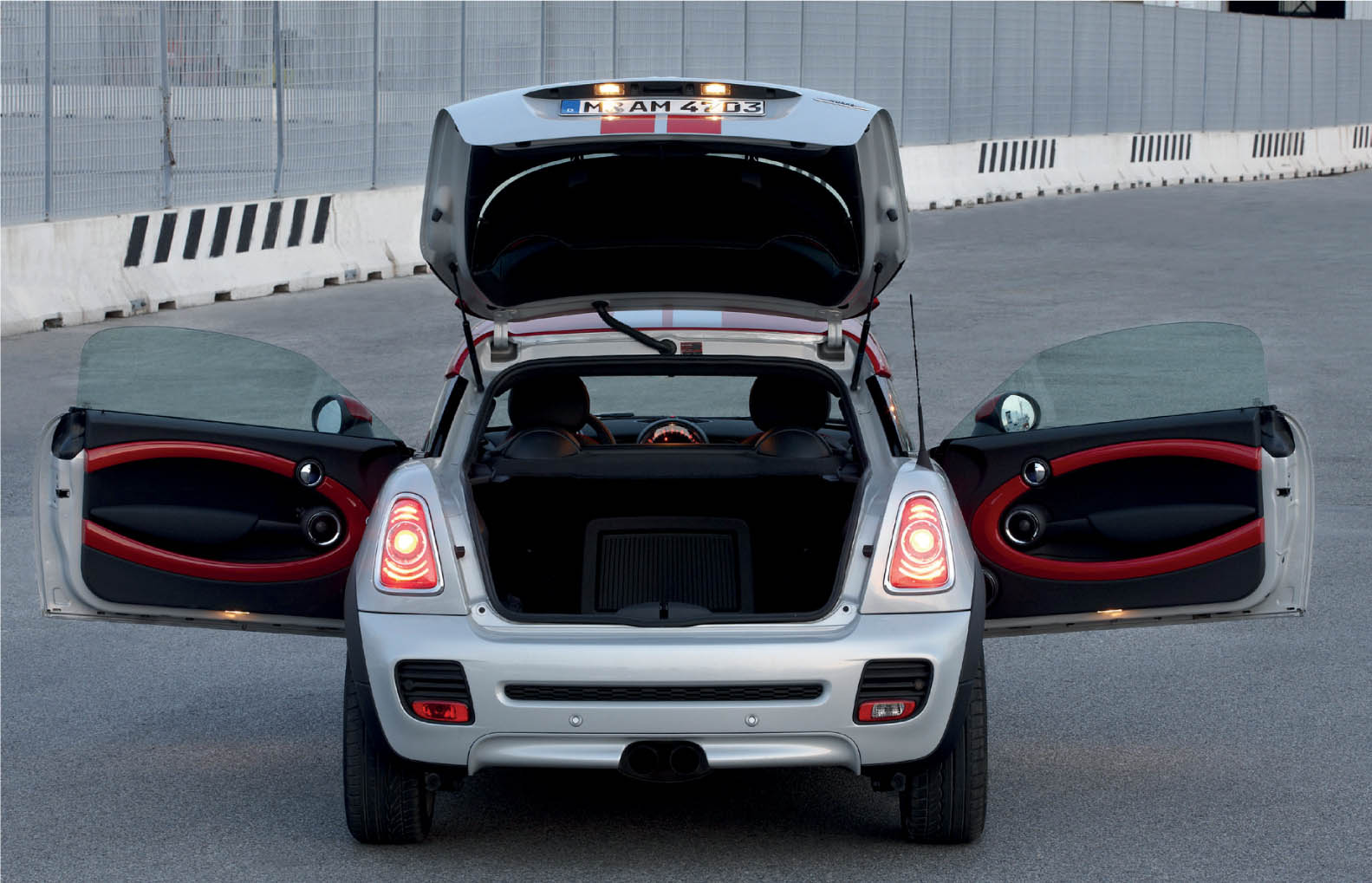
Since the Coupé doesn’t have rear seats, it boasts a healthy-sized 280ltr (9.9cu ft) boot. NEWSPRESS
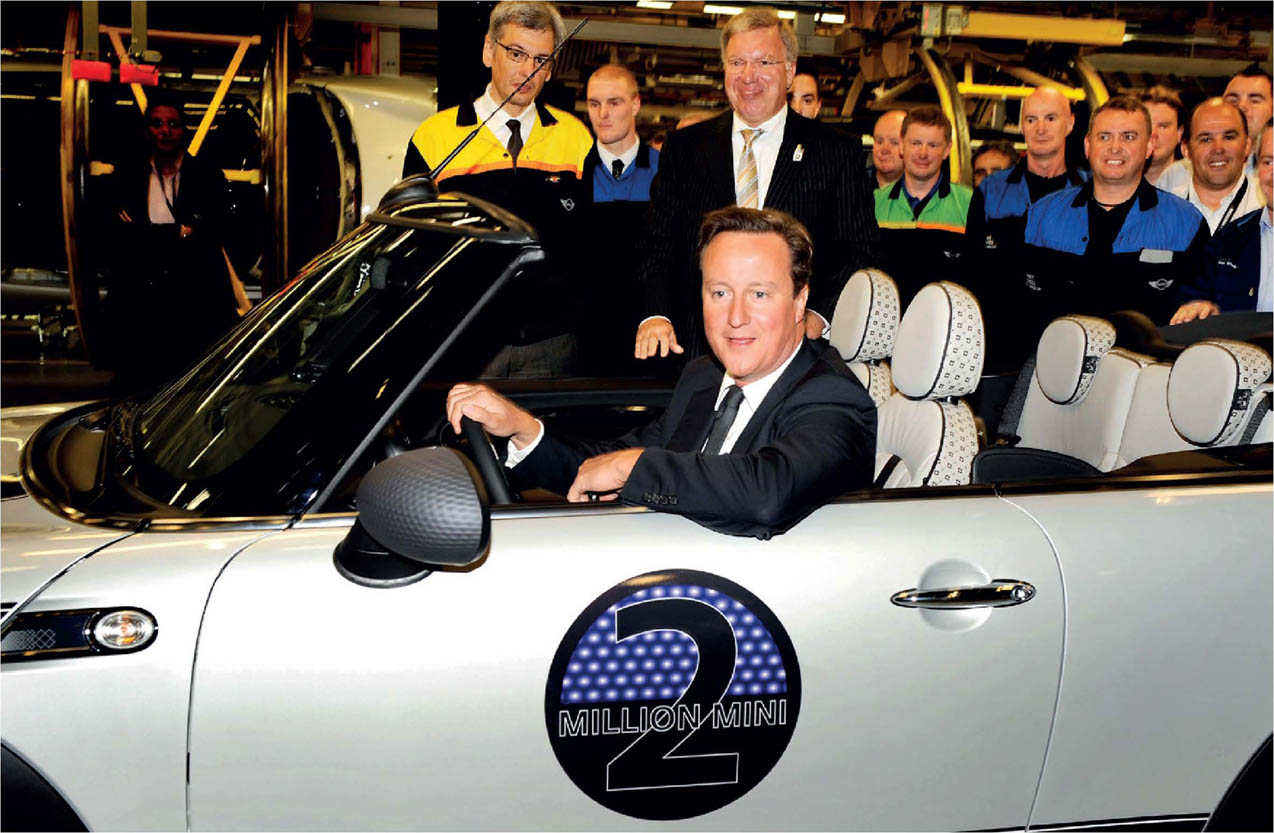
A decade after the very first R50 MINI rolled off the production line at MINI Plant Oxford, the 2 millionth example was driven off the line by Prime Minister David Cameron in September 2011. NEWSPRESS
The latest investment into the production facilities also took the company’s total investment figures across all UK operations to more than £1.5 billion since the year 2000. To put that in perspective, in 2001 approximately 2,400 associates worked in single shift operations, building 300 cars per day; by 2011 this had grown to 3,700 working a full five days per week to produce 900 MINIs per day. This means that maximum production capacity at Plant Oxford had risen from 100,000 to more than 200,000 units per year.
LONDON OLYMPICS 2012: THE OFFICIAL PARTNER OF TEAM GB AND PARALYMPICS GB
In 2012, the Olympics and Paralympics hit London – another perfect opportunity for MINI to shine. As the official partner of Team GB and Paralympics GB, MINI celebrated the Olympic Games by unveiling the London 2012 special: a limited edition of just 2,012 models, available in Cooper, Cooper D, Cooper S and Cooper SD form. As you’d expect, the cars were available in a ‘red, white and blue’ colour scheme, to honour the British Union Jack: Chilli Red, White Silver or Lightning Blue. To complete the design, each model was also given white mirror caps and a white roof, featuring the London 2012 Olympic graphic.
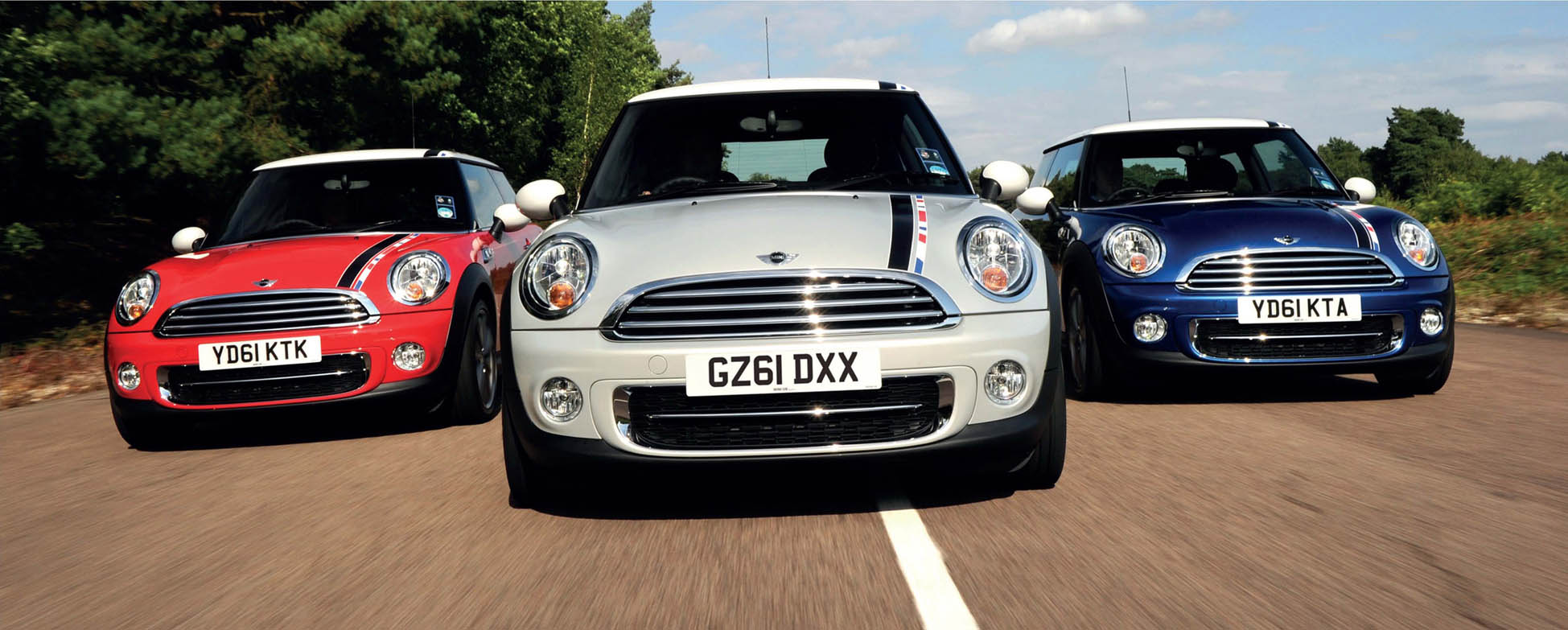
MINI celebrated the Olympic Games by unveiling the London 2012 special: a limited edition of just 2,012 models. NEWSPRESS
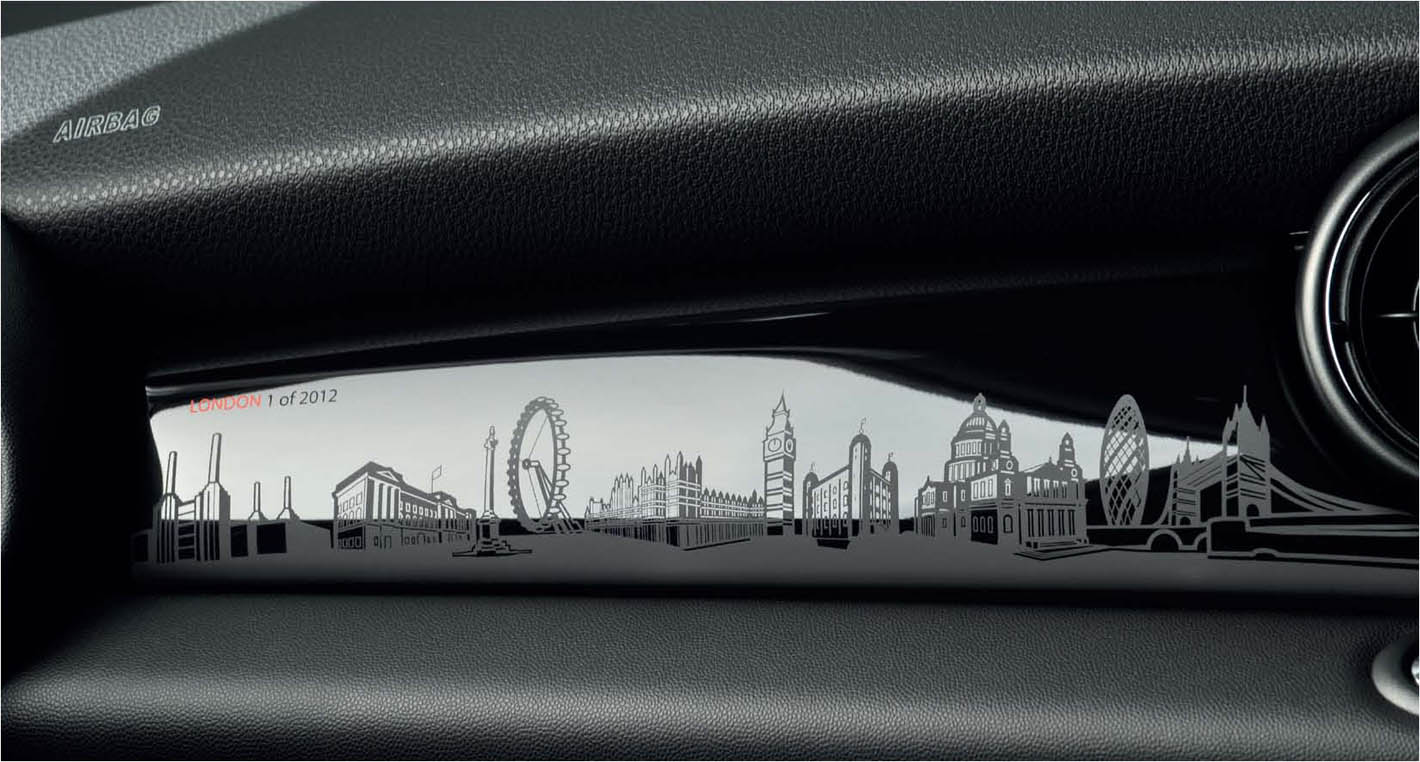
One of the London 2012 MINI’s more striking features is the London skyline, which is stitched across the width of the Piano Black dashboard. NEWSPRESS
THE MINI-ME
MINI’s involvement in London 2012 didn’t end with the launch of a special edition: the brand was also busy helping out in the Olympic stadium. If MINI wasn’t what people would call a ‘small car’ before, it certainly was now, because the infield of the Olympic Stadium was managed by a team of three MINI-me remote-control cars, helping to support the athletes. The little cars – roughly a quarter scale of the full-sized MINI – had been developed to carry a load of up to 8kg (18lb), two javelins or a singe hammer, discus or shot, and return them back from the field to the throwing areas to help save time during competition. They were powered by batteries that could last for up to 35min during continuous usage, with a radio-control range of 100m (328ft). Designed and built to a strict specification with LOCOG, the cars were all blue and wrapped in the same Olympic Games livery as the full-size fleet of official cars. The equipment could easily be placed and removed from inside the MINI-me’s cabin via the open sunroof. Of course, the little cars didn’t have a mind of their own and were operated by Game Makers, who’d had a lot of practice in controlling the cars around the infield.
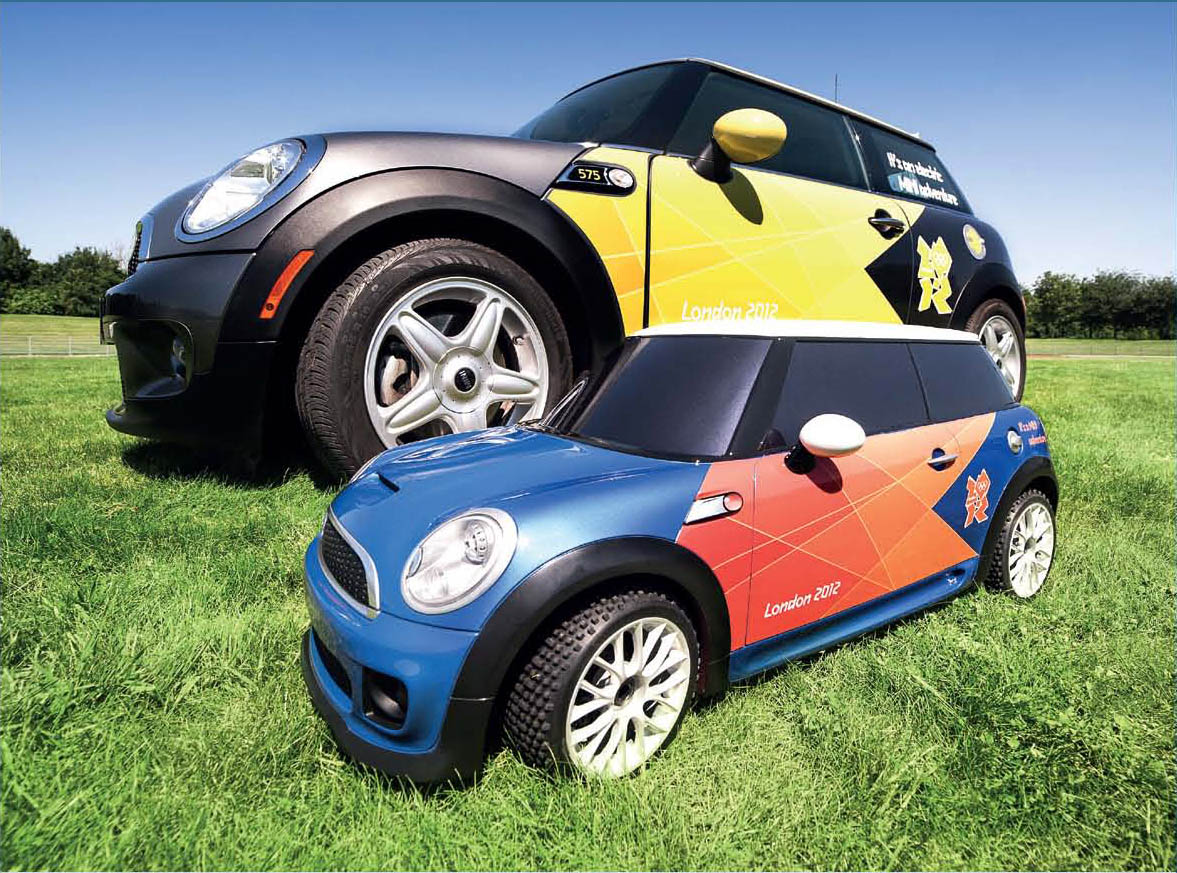
The infield of the Olympic Stadium was managed by a team of three MINI-me remote-control cars. NEWSPRESS
The MINIs did their fair share of exercise, travelling at least 4 miles (6.4km) per day during four-hour shifts across the full nine days of the London 20120 Games. As much as MINI fans would be desperate to get their hands on one, the MINI-mes were never offered to the public and are kept under lock and key at Oxford MINI until their next adventure call. They say good things come in small packages, and in this case, big things came in small packages.
The London 2012 special was also given a Union Flag sport strip, starting on the bonnet and ending at the boot. As well as bearing the official London Olympic decals, the limited edition can easily be identified by its bespoke grey 17in conical spoke alloy wheels.
However, it is inside the cabin that the MINI 2012 special really comes into its own: one of its more striking features is the London skyline, which has been stitched across the width of the Piano Black dashboard, silhouetting many of the city’s most iconic landmarks such as the London Eye, Tower Bridge and Battersea Power Station. To remind passengers that they’re driving in a unique little car, the dashboard also reads ‘London 1 of 2012’. The 2012 special hit the roads in March 2012, to coincide with the build-up to the London Olympic opening. Thankfully, the prices didn’t rocket for this particular edition. By this point, MINI had already positioned itself mid-way between value for money and premium, and understood the importance of remaining accessible, especially on such a monumental occasion. The Cooper hatch had a set price of £17,800, the Cooper D Hatch followed at £19,080, the Cooper S reached £20,125, with the Cooper SD ending at £20,860.
THE MINI ROADSTER
In spring 2012, MINI launched the convertible version of the Coupé, the MINI Roadster, which, like its hardtop sibling, was available across the range: the Cooper, Cooper S, Cooper SD and JCW. The Roadster, which became the sixth member of the MINI family, marked another first for MINI, being the first open-topped two-seater in the brand’s history. It was built at Plant Oxford in Cowley, and MINI claimed that the Roadster was the successor to the traditional British roadsters of the past. The Coupé was already tight on space, so taking off the roof wouldn’t appeal to buyers who relied on the boot space. However, the semi-automatic soft-top didn’t compromise the Roadster’s practicality in any way. It still boasts the through-loading, 240ltr (52gal) boot space, and features the same stowage areas behind the two seats. The Roadster models were priced between the entry level Cooper at £ 18,015 and the range-topping JCW at £24,850.
Like the hardtop Coupé, the Roadster was powered by BMW’s latest generation 4-cylinder petrol and diesel units, with power ranging from 122bhp to 21 Ibhp, while mpg fluctuated between 49.6mpg (5.7ltr/100km) and 38.7mpg (7.3ltr/100km) – depending on driving style. The Roadster’s moulded A-pillars and windscreen helped to reduce the front area of the car, meaning drag was also reduced. Coupled with the active rear spoiler, this means you can actually feel the Roadster sticking to the tarmac.
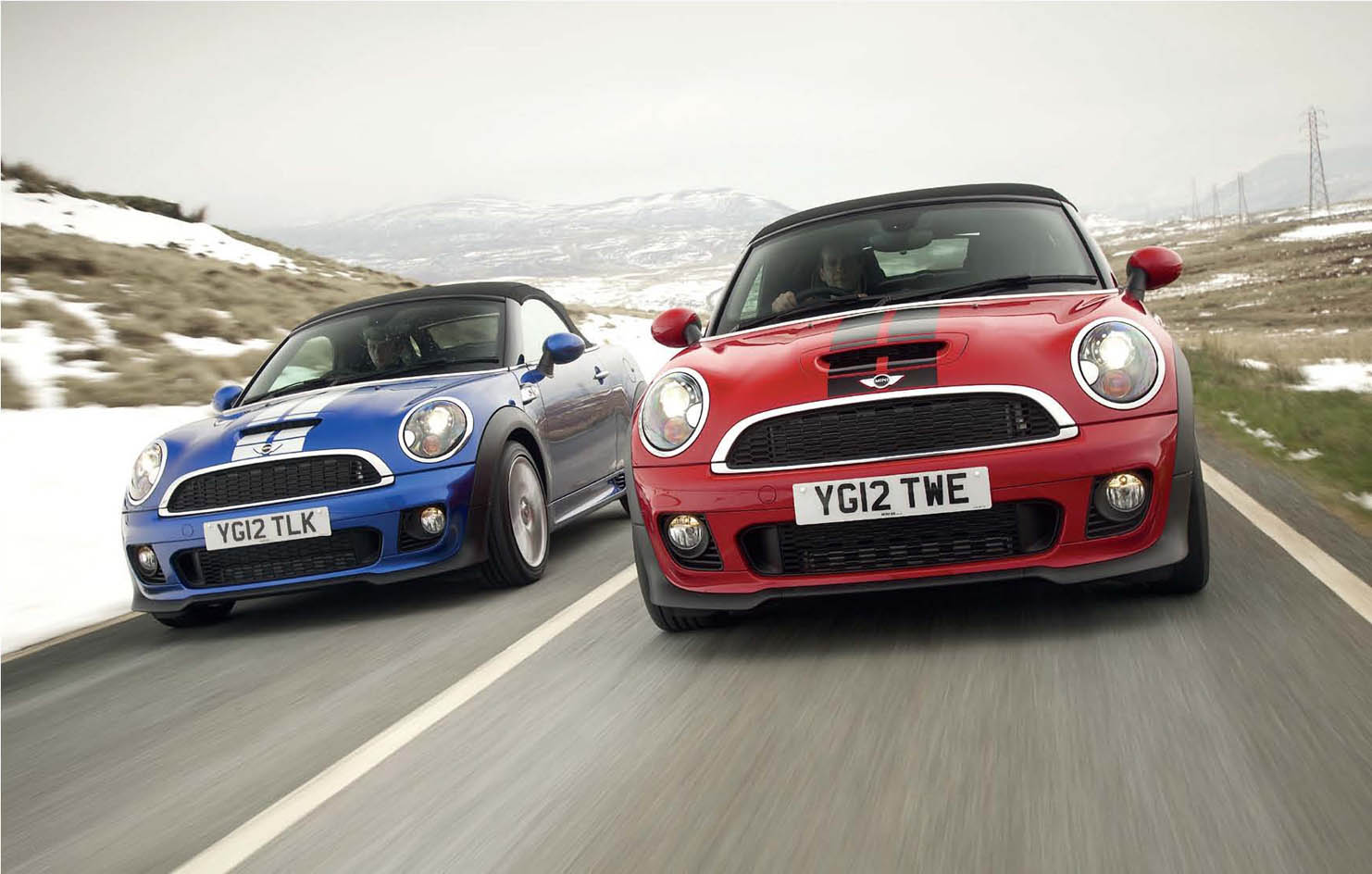
In spring 2012, MINI launched the convertible version of the Coupé – the MINI Roadster. NEWSPRESS
All Roadster models also received electric power steering (EPS) with speed-sensitive assistance and Sport mode as standard, allowing the driver to adjust the car’s steering characteristics and throttle responses, depending on the road and weather conditions. For customers who opt for a six-speed automatic gearbox, the Sport button also reduces shift times, meaning the Roadster can plough through the gears much more quickly than those with a standard six-speed manual. But just because it was fast, that didn’t mean to say it wasn’t efficient. The Roadster was also equipped with the brand’s MINIMALISM environmental technology as standard, which includes the auto stop/start system, shift point display and brake energy regeneration. In addition, the Roadster featured innovative encapsulation of the drivetrain, which shortens the warm-up period after a cold start and helps to reduce the amount of fuel it gulps during that process.
At launch, the new soft-top two-seater also came with a rather generous range of standard equipment (quite unusual for a MINI), including speed-sensitive steering assistance, heated mirrors, air conditioning, an MP3-compatible CD player and rear parking sensors. Just in case having the top down wasn’t enough of a tell-tale giveaway, the Roadster can be identified by its paint finish, in either two non-metallic or six metallic shades with a black roof and sports stripes, which are available in three colours, and 15in, 16in or 17in alloy wheels – the colour scheme and additional personalized stripes is what differentiates one Roadster from the next.
LONDON-BASED SPECIAL EDITIONS
Since MINI had already let its obsession with London and the 2012 Olympic Games be known, it was no surprise that the brand was planning another two special editions. Looking back, the marque’s obsession with London actually began in the 1980s, when Austin Rover launched the Mini Mayfair and the Mini Piccadilly. In March 2012, it was the MINI Baker Street and MINI Bayswater that were preparing to go on sale in 100 global markets, exclusive to the MINI Hatchback. Once again, the special edition cars remained rather modest in appearance, with only fine detailing distinguishing them from the rest.
For the MINI Baker Street and Bayswater, the focus was on colour schemes and trim levels. The Baker Street was available in One, One D, Cooper and Cooper D guise, finished in Rooftop Grey, or optional Pepper White and Midnight Black, with twin black bonnet stripes. The look was completed by 16in, six-star, twin-spoke alloy wheels in high-gloss black, to match the mirror cap, with ‘Baker Street’ decals added to the side scuttles and door sills. Much like the other MINIs, the Baker Street’s standard equipment list included automatic air conditioning, DAB radio, Bluetooth, fog lamps, and a multi-coloured interior lighting package. The entry-level MINI One Baker Street was priced from £16,365, while the top of the range Cooper D Baker Street with an automatic gearbox started from £ 19,945.
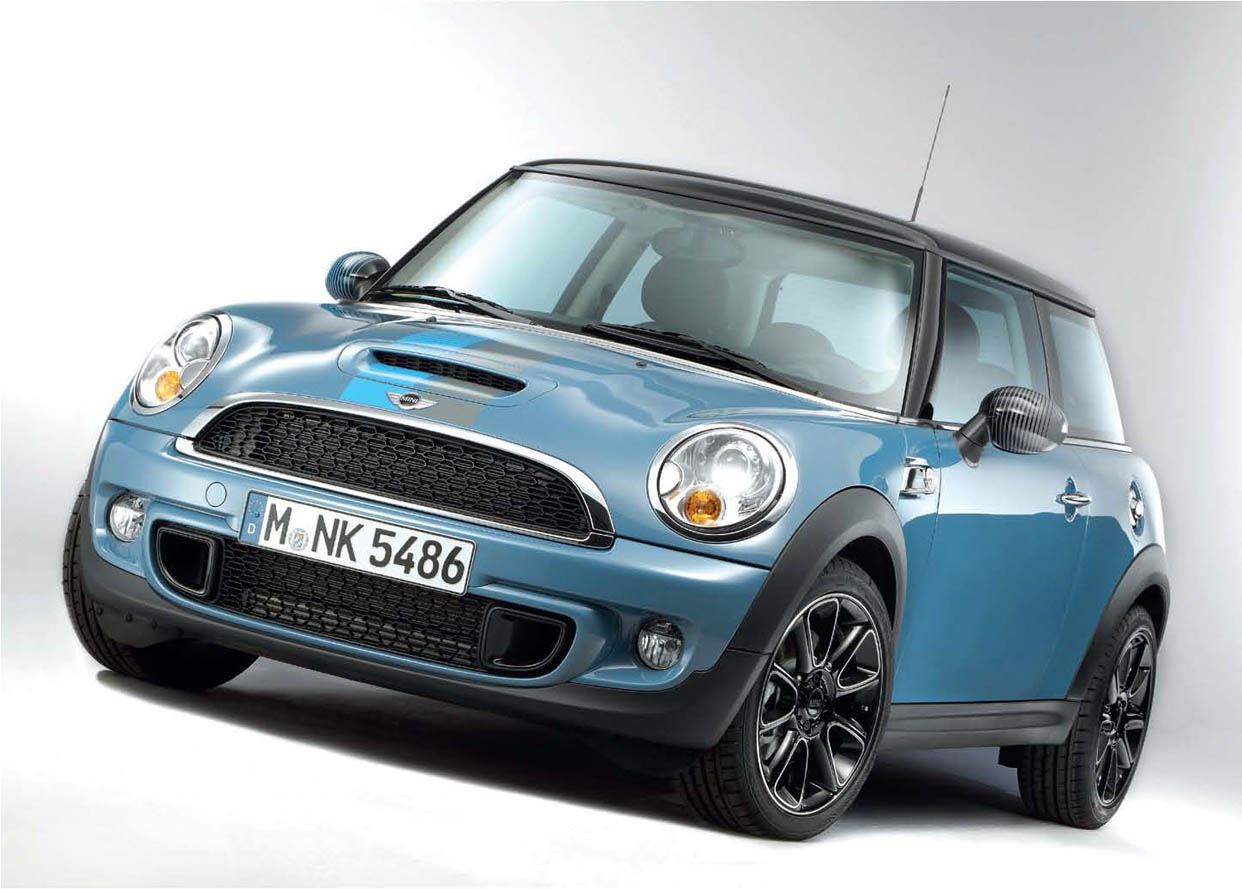
Following the Olympic Games, MINI launched the Baker Street and Bayswater editions. NEWSPRESS
While the Baker Street MINI was a conventional run-around, the Bayswater was labelled the sportier option, available on the MINI variants with more power: the Cooper, Cooper D, Cooper S and Cooper SD. The Bayswater was finished in Kite Blue metallic paint and 17in, high-gloss black, sandblast alloy wheels with machined rim and spoke edges, both of which are bespoke to the model. The Bayswater couldn’t be without ‘go-faster’ sport stripes on the bonnet, which were finished in blue and grey.
Being the sportier of the two cars, the Bayswater came with a larger price tag. The base model Cooper Bayswater started from £ 18,565, while the Cooper SD Bayswater with an automatic gearbox started from £23,375. Both cars came with a six-speed manual gearbox as standard, with an automatic transmission available as an option. The brand’s MINIMALISM technology also lowered the CO2 emissions of the One D and Cooper D models to 99g/km, making the two cars exempt from the London congestion charge – an added bonus for MINI fans living in and around the city.
THE GP2
Six years after the original Mini JCW Kit (GP1) stole our hearts away, BMW took the GP specification to another level. Since the all-new, second generation MINI had gone on sale in 2007, it was about time the GP was revived in the car’s new form. Sticking to the same raw, two-seater formula, the new GP – labelled GP2 – could clearly be distinguished through its beefed-up body kit and chintzy additions – only now, in 2012, the car was pushing £29,000, a price that wouldn’t just leave your pocket empty, but with a gaping great hole in it. Like its predecessor, the GP2 was also limited to a 2,000-only production run. The one significant difference between the two cars was the switch from a supercharger to a turbocharger, since all second generation MINI Cooper S and JCW variants received a 1.6-litre turbo engine over the former supercharged unit. Somehow, the turbo never lived up to the charm of whining supercharger (which also helped to disguise the less attractive whine from the failing power-steering pump), and the loss of the mechanical diff meant that it didn’t feel as planted on the road, either.
THE GROUNDBREAKING MINI: THE PACEMAN
Since the Countryman hadn’t turned out to be a huge hit with all MINI customers – or any good at gaining new ones, for that matter – BMW set out to broaden MINI’s target market by launching a cross between the MINI hatch and the MINI Countryman. This car would be named the Paceman, a threedoor SAV (sports activity coupé). Following the car’s appearance as a concept car at the Detroit Motor Show in 2011, senior vice-president of MINI brand management, Dr Kay Segler, announced in 2012 that ‘the MINI Paceman is the official name of the brand’s seventh model’, and would go on sale in 2013 with an entry-level starting price of £18,970.

The Paceman became the seventh model of the MINI family, hitting the road in 2013. NEWSPRESS
Introduced to celebrate ten years since the relaunch of the Mini marque, the Countryman Coupé – and the seventh MINI addition to the MINI range – would be built at Magna Steyr in Austria, alongside its bigger brother. Essentially, the Paceman was designed to appeal to customers who desired a spacious four-wheel-drive, but in the form of a coupé rather than a five-door saloon. The coupé interpretation of the Countryman is available in four versions, including the MINI Cooper S, which has an impressive 0–100km/h time of just 7.3sec – a rather impressive figure for a bulky MINI. Although the Coupé looked smaller than the Countryman, looks can be very deceiving, and bumper-to-bumper the Paceman Cooper was almost identical to the Countryman in length, at 4,109mm. This extended to 4,115mm for the Cooper S and Cooper SD Paceman models.

The Paceman marked the beginning of a new design language, ahead of the third generation MINI. NEWSPRESS
The Paceman also marked the beginning of a new design language, ahead of the third generation MINI. Its hexagonal grille and chrome surround gave it an immediate presence, not to mention its long, raked doors with blacked-out pillars, designed to create a ‘floating roof effect, similar to that of the MINI Coupé. To personalize the Paceman, the roof can be finished in black, white or body colour (not MINI’s most exciting colour theme), and slopes towards the rear of the car with an integrated spoiler. The horizontal rear lights curve from the rear to the side of the car, and it is these that were a first for the MINI. Since the Paceman was a rather different-looking MINI, it became the first model in the line-up to feature a rear nameplate. This would also become a standard feature for the Countryman later in the year, since it became apparent that the two cars were so similar in appearance that it was difficult for everyone to tell the difference.
The Paceman was also responsible for another MINI first, thanks to its innovative rear seat arrangement, which had been styled around a lounge concept and was strictly a two-seater. The arrangement provides such a level of increased head and legroom that, as a passenger, you actually feel as though you are sat in a lounge chair, especially with the integrated armrests and seat support. Although the Paceman is strictly a four-seater car, it is still practical. Focusing on the rear of the car, folding down the rear seats expands the boot space from 330 to 1,080ltr (11.7 to 38.1cu ft), which is easily accessed through the high-opening tailgate.
Although the Paceman features the signature centre speedometer, bespoke to MINI, another new addition to the MINI design was a black surround and decorative inner rings in high-gloss black or chrome. Similarly the window controls, which on every MINI up to this point had been in the form of toggle switches sat below the speedo, were moved to the trim panel on the doors, like the majority of cars on the road.
From launch the Paceman was offered with the choice of two petrol and two diesel engines, all of which were mated to a six-speed manual gearbox, or the optional automatic with Steptronic function for manual control. The 1.6-litre, 122bhp petrol unit offers a 0–60mph time of 10.4sec with a combined fuel consumption of 47.1mpg (6ltr/100km). The higher-performance Cooper S uses the same engine but is turbocharged and tuned to deliver 184bhp: this means it will sprint to 62mph (100km/h) in 7.5sec. The Cooper D uses a 1.6-litre 112bhp turbocharged engine, which can reach 0–60mph in an impressive 10.8sec, as well as providing 64.2mpg (4.4ltr/100km). The Cooper SD gained a 2.0-litre, 143bhp unit, with a 0–60mph time of 9.2sec and a consumption figure of 61.4mpg (4.6ltr/100km).
Like the Countryman, the Paceman Cooper D, Cooper SD and Cooper S were also available with MINI’s ALL4 four-wheel-drive system. Benefiting from MINI’s highly praised chassis technology, comprising MacPherson spring struts and forged cross members on the front axle, a multi-link rear axle and electric power steering with Servotronic, the Paceman is satisfyingly agile in the corners. Like the Countryman, the Paceman is also fitted with a range of driver aids, including dynamic stability control (DSC) standard across the range, and gadgets such as dynamic traction control (DTC) and electronic differential lock control (EDLC) available on the Cooper S, Cooper SD and Cooper D ALL4 models. The Paceman is the sensible car for not-so-sensible customers.
The Paceman didn’t stay sensible for long, though. In December 2012, MINI unveiled the JCW version of the sensible SAV, which eventually hit the roads in March 2013. It could reach a top speed of 140mph (225km/h), and its hefty horsepower was achieved through using the same engine that powered the Countryman JCW – the 1.6-litre, 215bhp with MINI ALL4. This particular model played a key role in pushing MINI prices even further, becoming the first MINI to achieve £30,000. Fitted with the six-speed CVT Steptronic automatic gearbox or the standard six-speed manual, the JCW Paceman could hit 62mph (100km/h) in under 7sec, and with manual transmission, had an estimated combined fuel consumption figure of 38.2mpg (7.4ltr/100km). The key alterations were made under the Paceman’s shell, where the suspension has been lowered by 10mm and the stability control system received an additional DTC mode, where the ALL4 torque split can be altered to send the full 100 per cent of its power to the rear wheels, rather than a 50/50 split.
In terms of appearance, the JCW Paceman can’t be missed, sharing the same red and black colour scheme – inside and out – as the outgoing MINI JCW models. The Chilli Red shade is reserved for the John Cooper Works model, and is stitched into the lounge leather sports seats, the sports steering wheel and the gear gaiter. The JCW Paceman features the same bold and seductive features as the MINI GP, with its twin viper stripes running along the length of the car, and its prominent aerodynamic kit.
MINI GOES COMMERCIAL: THE MINI CLUBVAN
Looking at the MINI range, it would appear that one particular model had been overlooked. Since Austin and Morris had released the Mini Pick-Up and Mini Van in the mid-1960s, it only seemed right that the modern MINI should follow in the same footsteps: enter the MINI Clubvan. It made its global debut at the Goodwood Festival of Speed in 2012, and was labelled a premium commercial vehicle with greater looks than the over-traditional work-horses. Based on the foundations of the MINI Clubman, the Clubvan was built at Plant Oxford in Cowley; featuring the same powertrain and chassis technology, it has five doors with split rears and a ‘Clubdoor’.
The Clubvan was launched in three forms: a MINI One Clubvan with 98bhp, the Cooper Clubvan with 122bhp and the Cooper D with 112bhp; all of them came with MINI’s front-wheel-drive set-up with electric power steering, MacPherson front suspension and multi-link rear suspension, and a six-speed manual gearbox as standard, although the six-speed automatic was also available. The boot space occupied the entire rear space, extending back from the rear double doors to the internal bulkhead – made from solid aluminium with a steel mesh – behind the driver and passenger seats.
The body-coloured side panels, where the Clubman’s windows would usually sit, featured polycarbonate reinforcement and provided the perfect canvas for business owners to display their brand name. The Clubvan does mean MINI, too, as not only does it boast a 115cm (45in) load area, which is also more than 102cm (40in) wide, it can also be loaded to the roofline, which is 84cm (33in) at its highest point. In total, the Clubvan has an 860ltr (30.4cu ft) luggage space. Unlike the Clubman, the commercial MINI was notably cheaper than the other seven members of the MINI family. Starting with the bottom-of-the-range One Clubvan, prices started from £ 11,175 and rose to £ 13,600 for the Cooper D.
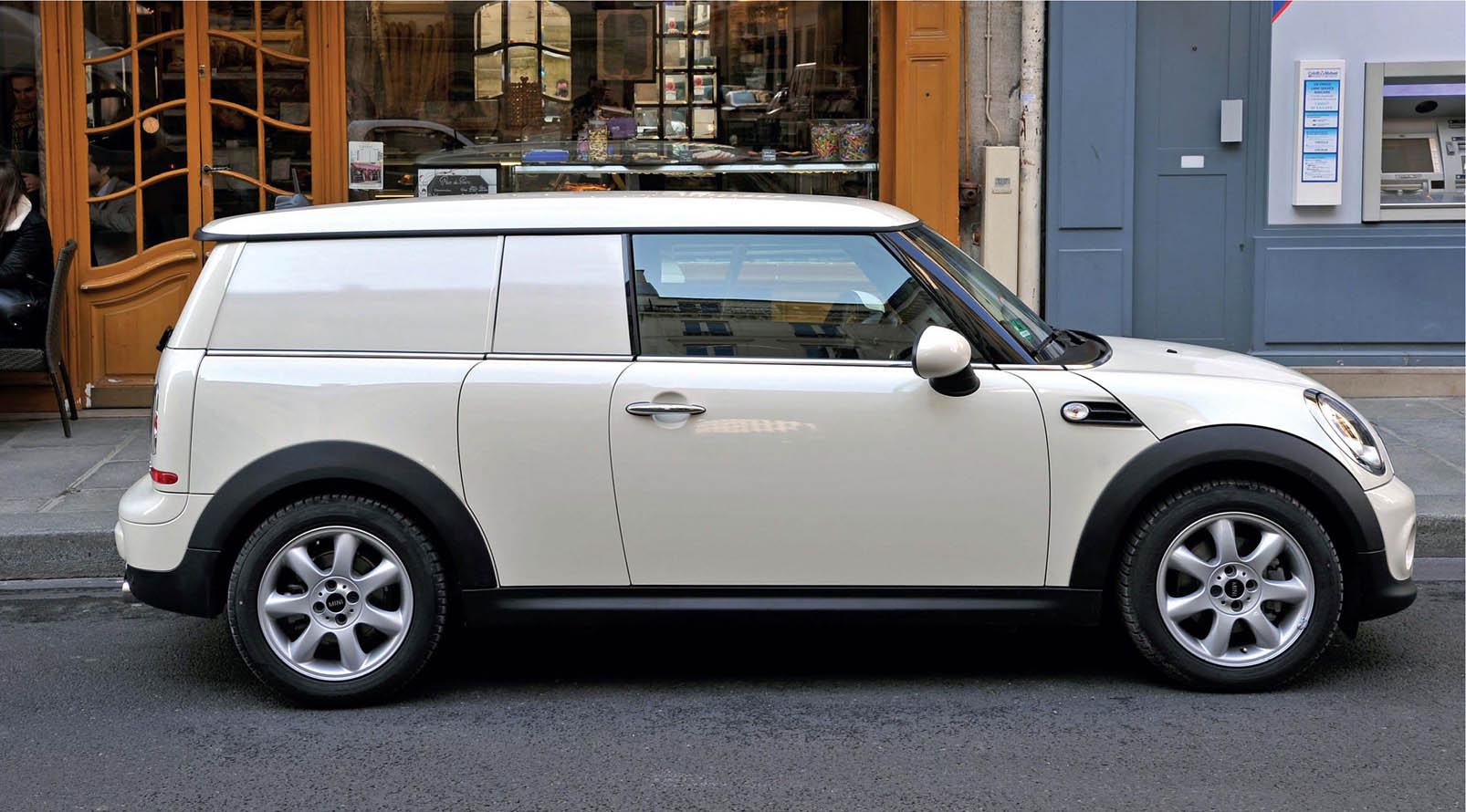
The Clubvan made its global debut at the Goodwood Festival of Speed in 2012. NEWSPRESS